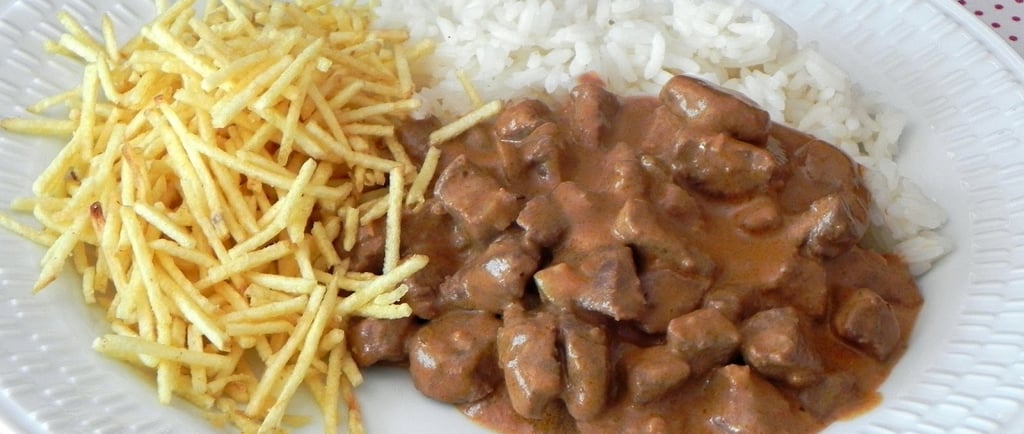Traditional Brazilian Strogonoff
Traditional Brazilian Strogonoff. There are records and culinary studies that show how Russian strogonoff was “Brazilianized” throughout the 20th century. The Brazilian adaptation is well documented in cookbooks, hotel menus, and domestic magazines from the 1940s to the 1980s. Here is the classic Brazilian strogonoff recipe, prepared in the most traditional way — creamy, simple, and served with white rice and crispy batata palha (shoestring potatoes).
RECIPE
Unveiled Brazil
11/23/20253 min read


Traditional Brazilian Strogonoff
Ingredients (serves 4)
For the strogonoff
500 g of chicken breast or 500 g of beef sirloin/round cut into strips
1 medium onion, chopped
2 garlic cloves, minced
1 tablespoon of butter or oil
Salt and black pepper to taste
1 tablespoon of ketchup
1 tablespoon of mustard
1 tablespoon of Worcestershire sauce (optional but commonly used in Brazil)
1/2 cup of tomato sauce (or well-diluted tomato paste)
1 box (200 g) of heavy cream
1/2 cup of sliced mushrooms (optional but traditional in the Brazilian version)
Sweet paprika (optional, adds color and flavor)
Side dishes
White rice
Crispy batata palha (Brazilian shoestring potatoes)
How to Prepare
1. Brown the chicken or beef
Heat the pan with butter or oil.
Add the chicken or beef and sauté until golden.
Season with salt and pepper.
2. Sauté the aromatics
Add the onion and cook until softened.
Add the garlic and sauté briefly (avoid burning it).
3. Build the base sauce
Add the ketchup, mustard, and Worcestershire sauce.
Mix in the tomato sauce.
Add the mushrooms (optional).
Cook for 2–3 minutes.
4. Finish with heavy cream
Turn off the heat (or keep it very low).
Add the heavy cream and stir until smooth and creamy.
Adjust salt, and add paprika if desired.
5. Serve
Serve immediately with fluffy white rice and batata palha.
Tips for the Perfect Result
Use boxed heavy cream (or equivalent) to prevent curdling.
For a thicker texture, add 1 tablespoon of cream cheese.
For a more Brazilian flavor, many people use slightly sweet ketchup.
For an elegant touch, finish with mushrooms and paprika.
Popular Brazilian Variations
Chicken strogonoff with corn
Beef strogonoff with cognac (flambé the meat first)
Shrimp strogonoff (cook very briefly to avoid toughness)
Fitness version: chicken with plain yogurt (instead of heavy cream)
How Strogonoff Became Brazilian — Historical Records
🇷🇺 ➜ 🇧🇷 1. Russian Origin and Arrival in Brazil (early 20th century)
The original dish, Bef Stroganoff, arrived in Brazil through two main routes:
Russian and Eastern European immigrants, especially after the Russian Revolution (1917).
Luxury hotel restaurants, which served the French-style version of the dish (with white wine, fresh cream, and mushrooms).
The earliest documented appearances on Brazilian menus date back to hotels in Rio de Janeiro and São Paulo in the 1920s–1930s, often spelled Stroganov or Stroganoff.
2. The Brazilian adaptation began in the 1940s
Women’s magazines of the time — such as “O Cruzeiro” and “A Cigarra” — published simplified recipes for home cooks.
During this period, the main changes began:
Replacement of fresh cream with canned/industrialized cream, which was cheaper and easier to find.
Use of ketchup and mustard, popular ingredients at the time that helped give the sauce its pinkish color without relying on fresh tomatoes.
3. The consolidation of “Brazilian strogonoff” (1960s–1970s)
It was in the 60s and 70s that the dish assumed the features now considered typical:
Documented changes:
✔ Batata palha (Brazilian-style shoestring potatoes) became the standard side dish.
✔ Sweeter sauce (due to Brazilian ketchup).
✔ Thinly sliced beef or cubed chicken — adaptations to Brazilian taste.
✔ Inclusion in cookbooks by Dona Benta and Helena Sangirardi, which helped popularize the national version.
Why did this happen?
Growth of the middle class and practical home cooking.
Popularization of pressure cookers and electric cookware.
Rise of industrialized food products in Brazil (boxed cream in the 1970s).
Influence of banquets and wedding buffets, where the dish became common.
Brazilian strogonoff became a symbol of festive home cooking, served at events and Sunday dinners.
4. The “chicken shift” (1980s–1990s)
Culinary magazines and TV cooking shows from the time indicate:
The chicken version became dominant in the 1980s, as poultry was cheaper than beef.
It became a staple in self-service restaurants, reinforcing its national identity.
Main Differences Between the Original Russian Strogonoff and the Brazilian Version
Are there reliable sources about this?
Yes. Among the most cited sources:
Brazilian cookbooks from the 1930s–1980s (Dona Benta, Helena Sangirardi, Ofélia).
Historical menus from hotels such as Copacabana Palace and Esplanada/SP.
Gastronomy articles from Revista Cláudia, O Cruzeiro, A Cigarra.
Interviews with chefs like Claude Troisgros discussing the adaptation of the dish in Brazil.
Academic research on migrant cuisine.
Summary
The Brazilian adaptation was a gradual process marked by:
substitutions with national or industrialized ingredients;
simplification for home cooking;
consolidation in buffets, weddings, and self-service restaurants;
creation of the typical side dish (batata palha + rice).
Brazilian strogonoff is therefore a Russian-French dish reinterpreted by Brazil’s 20th-century middle class.
